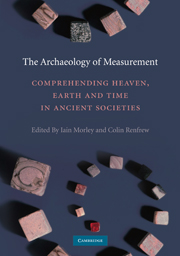Book contents
- Frontmatter
- Contents
- List of figures and tables
- List of contributors
- Acknowledgements
- The Archaeology of Measurement
- Introduction: Measure: Towards the construction of our world
- SECTION I NUMBER: COUNTING, MATHEMATICS AND MEASURE
- 1 Conceptualising quantification before settlement: Activities and issues underlying the conception and use of measurement
- 2 Measurement in navigation: Conceiving distance and time in the Neolithic
- 3 The token system of the ancient Near East: Its role in counting, writing, the economy and cognition
- 4 Grasping the concept of number: How did the sapient mind move beyond approximation?
- 5 Numerical cognition and the development of ‘zero’ in Mesoamerica
- 6 Recording measure(ment)s in the Inka khipu
- SECTION II MATERIALISING THE ECONOMY
- SECTION III DIMENSIONS AND BELIEF
- SECTION IV CALENDAR AND COSMOLOGY
- SECTION V THE SPIRITUALITY OF MEASURE
- Index
- References
6 - Recording measure(ment)s in the Inka khipu
Published online by Cambridge University Press: 05 June 2012
- Frontmatter
- Contents
- List of figures and tables
- List of contributors
- Acknowledgements
- The Archaeology of Measurement
- Introduction: Measure: Towards the construction of our world
- SECTION I NUMBER: COUNTING, MATHEMATICS AND MEASURE
- 1 Conceptualising quantification before settlement: Activities and issues underlying the conception and use of measurement
- 2 Measurement in navigation: Conceiving distance and time in the Neolithic
- 3 The token system of the ancient Near East: Its role in counting, writing, the economy and cognition
- 4 Grasping the concept of number: How did the sapient mind move beyond approximation?
- 5 Numerical cognition and the development of ‘zero’ in Mesoamerica
- 6 Recording measure(ment)s in the Inka khipu
- SECTION II MATERIALISING THE ECONOMY
- SECTION III DIMENSIONS AND BELIEF
- SECTION IV CALENDAR AND COSMOLOGY
- SECTION V THE SPIRITUALITY OF MEASURE
- Index
- References
Summary
Introduction
The objective of this chapter is to explore various features of the encoding of information in the khipu (Quechua: ‘knot’), the knotted-string device used for record keeping in the Inka empire of pre-Columbian South America. Specifically, I will discuss what the testimony concerning khipus contained in Spanish colonial documents, as well as study of museum samples of khipus, can teach us about the types and standards of measurements used by local and state administrators in the Inka empire. Given these objectives, we should be clear from the beginning about the range of concepts and practices connected with ‘measure’ and ‘measurement’, at least as these are understood in English. To measure means “to compute, estimate, or ascertain the extent, quantity, dimensions, or capacity of [something], especially by a certain rule or standard” (Webster's New Twentieth Century Dictionary 1978). In addition to this dauntingly wide range and variety of activities, measurement involves more abstract concepts and forms of evaluation, including “to estimate by reference to any standard; to judge of the value, extent, magnitude, or greatness of [something/someone]” (Webster's New Twentieth Century Dictionary 1978).
Clearly, if our objective here is to discuss the recording of measure(ment)s in the Inka khipus, we will have to find some way to limit the domains of reference, as space will not permit a full consideration of the many and varied principles and activities evoked previously.
- Type
- Chapter
- Information
- The Archaeology of MeasurementComprehending Heaven, Earth and Time in Ancient Societies, pp. 54 - 68Publisher: Cambridge University PressPrint publication year: 2010
References
- 6
- Cited by

